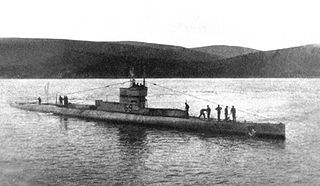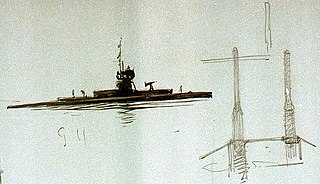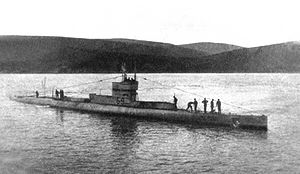HMS A2 was an A-class submarine built for the Royal Navy in the first decade of the 20th century.

The Royal Navy's G class of diesel/electric submarines were launched between 1914 and 1917, and intended for operations in the North Sea and German Bight in World War I against German U-boats.

HMS L52 was a late-model L-class submarine built for the Royal Navy during the First World War. The boat was not completed before the end of the war and was sold for scrap in 1935.
HMS L56 was a late-model L-class submarine built for the Royal Navy during the First World War. The boat was not completed before the end of the war and was sold for scrap in 1938.

HMS L9 was an L-class submarine built for the Royal Navy during World War I. The boat survived the war and was sold for scrap in 1927.
HMS L23 was a L-class submarine built for the Royal Navy during World War I. The boat was not completed before the end of the war and was one of three L-class boats to serve during World War II. L23 was sold for scrap in 1946.
HMS L21 was a L-class submarine built for the Royal Navy during World War I. The boat was not completed before the end of the war and was sold for scrap in 1939.

HMS L22 was a L-class submarine built for the Royal Navy during World War I. The boat was not completed before the end of the war and was sold for scrap in 1935.

HMS G1 was a British G-class submarine built for the Royal Navy during World War I.

HMS G3 was a British G-class submarine built for the Royal Navy during World War I.

HMS G4 was a British G-class submarine built for the Royal Navy during World War I.

HMS G5 was a British G-class submarine built for the Royal Navy during World War I.

HMS G6 was a British G-class submarine built for the Royal Navy during World War I.

HMS G7 was a British G-class submarine built for the Royal Navy during World War I.

HMS G8 was a G-class submarine of the Royal Navy that saw service during World War I, costing an estimated £125,000.

HMS G10 was a British G-class submarine built for the Royal Navy during World War I.

HMS G11 was a G-class submarine of the Royal Navy in service during the First World War. One of six of her class built by Vickers at Barrow in Furness, she was launched on 22 February 1916, and commissioned on 13 May 1916.

HMS G12 was a British G-class submarine built for the Royal Navy during World War I.

HMS G13 was a British G-class submarine built for the Royal Navy during World War I.

HMS G14 was a British G-class submarine built for the Royal Navy during World War I.







